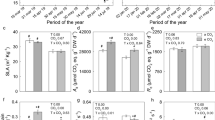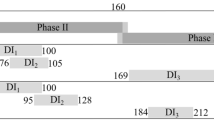Abstract
In Rosaceae fruit tree species, fruit and roots grow opposite because of carbohydrate competition, and root activity is thus reduced by fruit growth. In agreement with this, for some of these species soil temperature has been suggested as a factor regulating fruit ripening, but the mechanism with which it works remains unknown. In this study, we reduced loquat root activity by lowering soil temperature, expecting faster fruit growth and advanced fruit ripening. Eight 4-year-old ‘Algerie’ loquat trees, budded onto seedling rootstock, and grown outdoors in 39-l plastic containers filled with sandy-loamy soil were used. The roots of four trees were cooled by placing the containers in a cooling compartment (9.5 °C), whereas those of the other four trees were maintained at air temperature (16.5 °C). We measured lateral root primordia emergence, fruit diameter and fruit color development, carbohydrates and nitrogen partitioning, as well as GA, CK, IAA, ABA, and JA content. Lowering soil temperature increased carbohydrate translocation to the fruit and reduced root N uptake and translocation to both the canopy and the fruit. Changes in plant hormones were also caused by reduced soil temperature, and fruit color advanced. Loquat fruit ripened 8–10 days earlier when soil temperature was reduced to 9.5 °C.






Similar content being viewed by others
References
Agustí M, Guardiola JL, Almela V (1981) The regulation of fruit cropping in mandarins through the use of growth regulators. Proc Int Soc Citricult 1:216–220
AOAC (2005) Official methods of analysis of the association of official analytical chemists, 14th edn. AOAC, Arlington, pp 611–613
Bryla DR, Bouma TJ, Hartmond U, Eissenstat DM (2001) Influence of temperature and soil drying on respiration of individual roots in citrus: integrating greenhouse observations into a predictive model for the field. Plant Cell Environ 24:781–790
Canellas LP, Lopes F, Okorokova-Façanha AL, Rocha A (2002) Humic acid isolated from earthworm compost enhance root elongation, lateral root emergence, and plasma membrane H+-ATPase activity in maize roots. Plant Physiol 130:1951–1957
Coggins CW Jr (1981) The influence of exogenous growth regulators on rind quality and internal quality of citrus fruits. Proc Int Soc Citriculture 1:214–216
Ebel RC, Proebsting EL, Patterson ME (1993) Regulated deficit irrigation may alter apple maturity, quality, and storage life. HortScience 28:141–143
Feller U, Fischer A (1994) Nitrogen metabolism in senescing leaves. Crit Rev Plant Sci 13:241–273
Gambetta G, Martínez-Fuentes A, Betancur O, Mesejo C, Reig C, Gravina A, Agustí M (2012) Hormonal and nutritional changes in the flavedo regulating rind color development in sweet orange [Citrus sinensis (L.) Osb.]. J Plant Growth Regul 31:273–282
Gross J, Bazak H, Blumenfeld A (1984) Changes in chlorophyll and carotenoid pigments in the peel of ‘Triumph’ persimmon (Diospyros kaki L.) induced by pre-harvest gibberellin (GA3) treatment. Sci Hortic 24:305–314
Iglesias DJ, Tadeo FR, Legaz F, Primo-Millo E, Talón M (2001) In vivo sucrose stimulation of color change in citrus fruit epicarps: interactions between nutritional and hormonal signals. Physiol Plant 112:244–250
Jiang K, Feldman LJ (2003) Root meristem establishment and maintenance: the role of auxin. J Plant Growth Regul 21:432–440
Kondo S, Tomiyama A, Seto H (2000) Changes of endogenous jasmonic acid and methyl jasmonate in apples and sweet cherries during fruit development. J Am Soc Hortic Sci 125:282–287
Kondo S, Ponrod W, Kanlayanarat S, Hirai N (2002) Abscisic acid metabolism during fruit development and maturation of mangosteens. J Am Soc Hortic Sci 127:737–741
Krauss A (1985) Interaction of nitrogen nutrition, phytohormones and tuberization. In: Li PH (ed) Potato physiology. Academic Press, London, pp 209–231
Letham DS (1994) Cytokinins and phytohormones—sites of biosynthesis, translocation and function of translocated cytokinin. In: Mok DW, Mok MC (eds) Cytokinins-chemistry, activity, and function. CRC Press, Boca Raton, pp 57–80
Lou H, Chen P, Zheng H, Xu C, Lu H (2012) Effect of kinetin on quality and harvest date of loquat fruit. Afr J Agric Res 7:1577–1583
Manning K (1993) Soft fruit. In: Seymour JB, Taylor JE, Tucker GA (eds) Biochemistry of fruit ripening. Chapman & Hall, London, pp 347–378
Mesejo C, Gambetta G, Gravina A, Martínez-Fuentes A, Reig C, Agustí M (2011) Relationship between soil temperature and fruit color development of ‘Clemenpons’ Clementine mandarin (Citrus clementina Hort ex. Tan). J Sci Food Agric 92:520–525
Myers SC (1992) Root restriction of apple and peach in in-ground fabric containers. Acta Hortic 322:215–219
Noodén LD (1988) The phenomena of senescence and aging. In: Noodén LD, Leopold AC (eds) Senescence and aging in plants. Academic Press, San Diego, pp 1–50
Quiñones A, Legaz F (2006) Nutrición mineral. Fertilización. In: Agustí M, Reig C, Undurraga P (eds) El cultivo del níspero japonés. Alcoy, Gráficas Alcoy, pp 131–162
Raigón MD, Pérez-García M, Maquieira A, Puchades R (1992) Determination of available nitrogen (nitric and ammoniacal) in soils by flow injection analysis. Analysis 20:483–487
Reig C, Mesejo C, Martínez-Fuentes A, Iglesias DJ, Agustí M (2013) Fruit load and root development in field-grown loquat trees (Eriobotrya japonica Lindl.). J Plant Growth Regul 32:281–290
Reig C, Mesejo C, Martínez-Fuentes A, Martínez-Alcántara B, Agustí M (2015) Loquat fruit ripening is associated with root depletion. Nutritional and hormonal control. J Plant Physiol 177:51–59
Reig C, Martínez-Fuentes A, Mesejo C, Rodrigo MJ, Zacarías L, Agustí M (2016) Loquat fruit lacks a ripening-associated autocatalytic rise in ethylene production. J Plant Growth Regul 35:232–244
Richmond AE, Lang A (1957) Effect of kinetin on protein content and survival of detached Xanthium leaves. Science 125:650–651
Sakakibara H (2006) Cytokinins: activity, biosynthesis, and translocation. Annu Rev Plant Biol 57:431–449
Seo M, Jikumaru Y, Kamiya Y (2011) Profiling of hormones and related metabolites in seed dormancy and germination studies. Methods Mol Biol 773:99–111
Skoog F, Miller CO (1957) Chemical regulation of growth and organ formation in plant tissues cultured in vitro. In Vitro Symp Soc Exp Biol 11:118–131
Takahashi N, Yamazaki Y, Kobayashi A, Higashitani A, Takahashi H (2003) Hydrotropism interacts with gravitropism by degrading amyloplasts in seedling roots of Arabidopsis and radish. Plant Phys 132:805–810
Wang H, Huang H, Huang Y (2007) Differential effects of abscisic acid and ethylene of the fruit maturation of Litchi chinensis Sonn. Plant Growth Regul 52:189–198
Young LB, Erickson LC (1961) Influence of temperature on color change in Valencia oranges. Proc Am Soc Hortic Sci 78:197–200
Acknowledgments
We thank Dr. Isabel López-Días and Dr. Esther Carreras, IBMCP-UPV (Valencia, Spain) for hormone quantification, and Dr. Debra Westall (UPV) for editing the manuscript.
Author information
Authors and Affiliations
Corresponding author
Rights and permissions
About this article
Cite this article
Reig, C., Grillone, N., Mesejo, C. et al. Soil Temperature Regulates Fruit Color Change in ‘Algerie’ Loquat: Nutritional and Hormonal Control. J Plant Growth Regul 35, 1108–1117 (2016). https://doi.org/10.1007/s00344-016-9608-z
Received:
Accepted:
Published:
Issue Date:
DOI: https://doi.org/10.1007/s00344-016-9608-z




